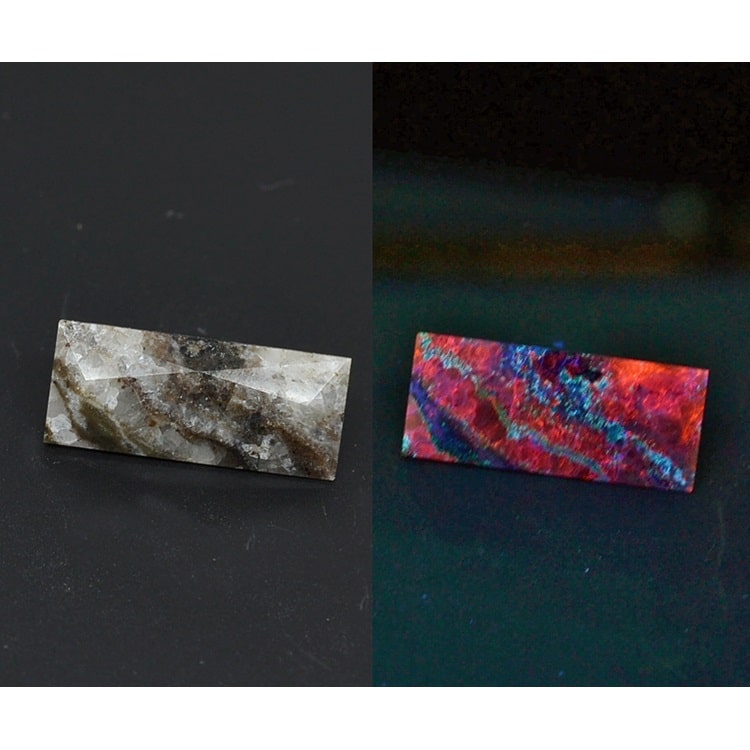Fluorescent gemstones have long captured the imagination of scientists, jewelers, and enthusiasts alike. These rare stones emit a glowing light when exposed to ultraviolet (UV) radiation, creating an otherworldly effect that has fascinated people for centuries. In the United States, where gemstone appreciation is deeply rooted in both history and modern culture, fluorescent gemstones are gaining renewed interest. From ancient legends to contemporary jewelry design, these gems offer a unique blend of science and beauty.
The Science Behind Fluorescence
Fluorescence is a natural phenomenon that occurs when certain minerals absorb energy from UV light and re-emit it as visible light. This process involves the excitation of electrons within the gemstone’s atomic structure. When these electrons return to their ground state, they release energy in the form of light. Not all gemstones exhibit this property—only about 15% of mineral species do. Among them, some of the most well-known include rubies, sapphires, diamonds, and emeralds.
The intensity and color of the glow depend on the specific impurities or activator elements present in the gemstone. Common activators include chromium, titanium, and rare earth elements. For example, rubies often glow red due to chromium, while some sapphires may display orange-pink hues. The Hope Diamond, one of the world’s most famous gems, is known for its striking red phosphorescence under UV light.
Historical Fascination with Glowing Gems

Long before the science of fluorescence was understood, glowing gemstones inspired myths and legends across different cultures. In ancient India, stories of luminous jewels were woven into religious texts. The Vishnu Purana described the god Vishnu’s serpent avatar, Shesha, adorned with glowing jewels. Similarly, the Mahabharata spoke of a palace filled with precious stones that “shine like lamps.”
In Greece and Rome, glowing gems were also part of cultural narratives. Herodotus wrote about a temple column made of green gems that glowed at night, while Pliny the Elder described a gem called chrysolampis that turned fiery by night. These accounts, though possibly exaggerated, reflect the awe that glowing stones inspired in ancient times.
In Egypt, miners on the island of Zabargad (now known as Topazios) reportedly used the glow of peridot to locate their treasures. Though peridot itself is not luminescent, the stories surrounding it helped elevate its status in the ancient world. Today, the Sterling Hill Mine in New Jersey is home to one of the largest collections of fluorescent rocks, offering a glimpse into the same phenomenon that once captivated ancient civilizations.
Fluorescent Gemstones in Modern Jewelry

In the United States, fluorescent gemstones are increasingly being incorporated into high-end jewelry. Designers and jewelers are drawn to the unique visual effects that fluorescence can create, especially under blacklight or in certain lighting conditions. For instance, a ruby that glows intensely under UV light can add an extra dimension of beauty to an engagement ring or pendant.
One of the most notable examples is the Hope Diamond, which continues to be a subject of fascination. Its red phosphorescence, visible even after the UV light is turned off, makes it a standout piece. Other gemstones, such as opals and citrines, can also exhibit fluorescence, though the effect is often more subtle.
How Fluorescence Affects Value and Appearance

While fluorescence can enhance the visual appeal of a gemstone, it can also impact its value. In diamonds, for example, blue fluorescence is common and can sometimes make a slightly yellowish diamond appear whiter in daylight. However, strong fluorescence may cause a hazy appearance in rare cases, which could lower the stone’s value.
For other gemstones, such as emeralds, fluorescence can help identify whether a stone has been treated with fillers. Natural emeralds typically do not fluoresce, while synthetic ones often do. This distinction is important for collectors and buyers who want to ensure the authenticity of their gems.
Testing and Identifying Fluorescent Gemstones

Gemologists use UV light to test and identify fluorescent gemstones. This method can reveal information about a stone’s origin, treatment, and authenticity. For example, synthetic rubies often fluoresce more brightly than natural ones, making it easier to distinguish between the two. Similarly, certain types of fillers used in emeralds will fluoresce differently than the stone itself.
There are also specialized tools, such as crossed filters and spectrometers, that can provide more detailed analysis. These techniques are essential for ensuring that gemstones are accurately classified and valued.
Caring for Fluorescent Gemstones
Like all gemstones, fluorescent ones require proper care to maintain their brilliance and longevity. Regular cleaning with mild soap and water is recommended, and harsh chemicals should be avoided. It’s also important to store them separately to prevent scratches or damage.
Some owners enjoy showcasing their fluorescent gemstones under UV light, using them as conversation starters at parties or events. This unique feature adds an extra layer of intrigue to these already captivating stones.
Conclusion: The Enchantment of Fluorescent Gemstones
Fluorescent gemstones continue to captivate people with their mesmerizing glow. From ancient legends to modern jewelry design, these stones represent a fascinating intersection of science and art. Whether you’re a collector, a jeweler, or simply someone who appreciates the beauty of nature, fluorescent gemstones offer a unique and enchanting experience.
As research into gemstone properties continues, we can expect to learn even more about the mysteries of fluorescence. For now, one thing is clear: these glowing gems are more than just beautiful—they’re a testament to the wonders of the natural world.
Meta Title: US Trending News: Fluorescent Gemstones Explained
Meta Description: Discover what makes fluorescent gemstones unique and why they’re trending in the US. Learn about their history, science, and modern applications.
Author: Sarah Thompson
Title/Role: Gemologist and Jewelry Historian
Credentials: With over a decade of experience in gemology and jewelry design, Sarah has written extensively on the history and science of gemstones. She is a member of the Gemological Institute of America (GIA).
Sources:
– Gemological Institute of America
– Sterling Hill Mine Official Website
– The Hope Diamond – Smithsonian Institution
Internal Links:
– The History of Diamonds
– How to Care for Your Jewelry
– Top US Gemstone Markets
Featured Snippet Optimization:
Fluorescent gemstones are rare stones that emit light when exposed to UV radiation. This phenomenon occurs due to trace elements in the gemstone’s atomic structure, which absorb energy and re-emit it as visible light. Examples include rubies, sapphires, and diamonds. Their glow has fascinated people for centuries, inspiring myths and modern jewelry design.
Call to Action:
Stay updated with the latest news on gemstones and their unique properties. Explore our collection of fluorescent jewelry today!










More Stories
What Is Yodo Para Tiroides and How Does It Affect Thyroid Health?
How to Claim Your Joy in League of Legends: A Step-by-Step Guide
What is WSET? A Comprehensive Guide to Wine Education